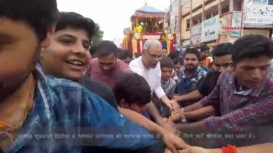Bastar has for long held strong ties with the adjoining region of Odisha. Halbi, one of the two main dialects spoken in Bastar, reflects the influence of the Odia dialect. Kingship in Bastar drew power and legitimacy through an association with the Jagannath temple in Odisha, and ratha jatras became a conduit for the public display of kingship and divinity. Purshottam Dev, the Kakatiya ruler of Bastar travelled to Puri in the fifteenth century, forging a link with the temple, and bringing back with him the practice of the ratha jatra. While the Bastar Dussehra is a celebration of the power of the goddess Danteshwari who arrived from Warangal with Annamdeva in the thirteenth-fourteenth centuries, Goncha is a celebration of the cult of Jagannath in Bastar, bringing in distinctly Odiya practices into the landscape of Bastar. Unlike the complete acculturation of the cult of Danteshwari in Bastar, the Jagannath cult remained relatively un-assimilated.
This content has been created as part of a project commissioned by the Directorate of Culture and Archaeology, Government of Chhattisgarh, to document the cultural and natural heritage of the state of Chhattisgarh.



